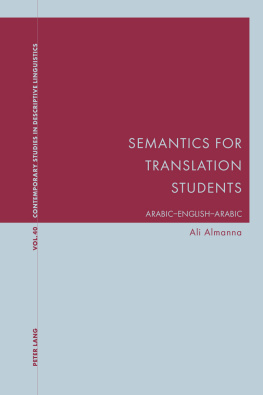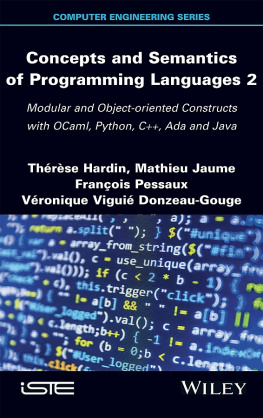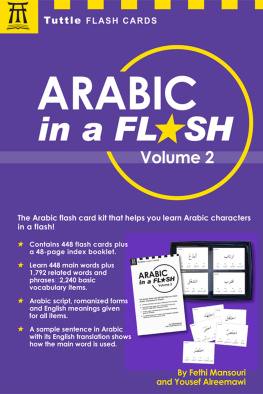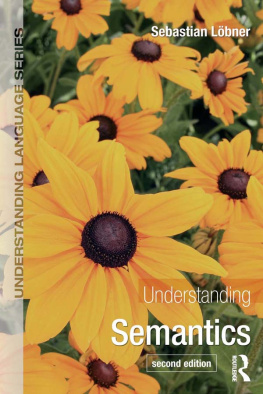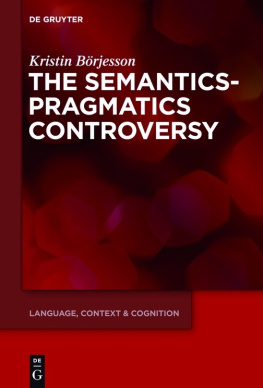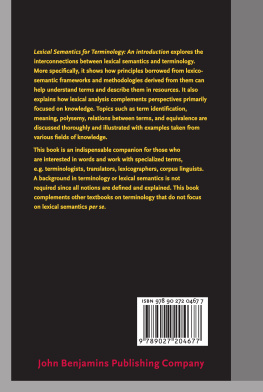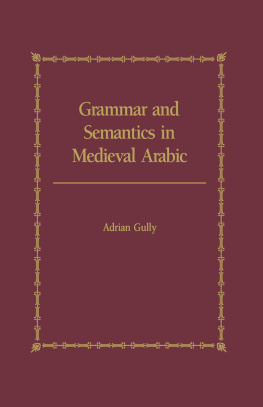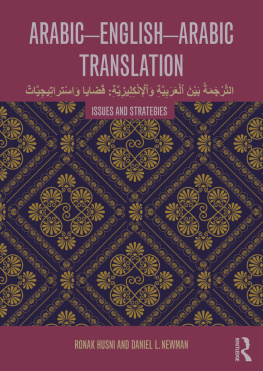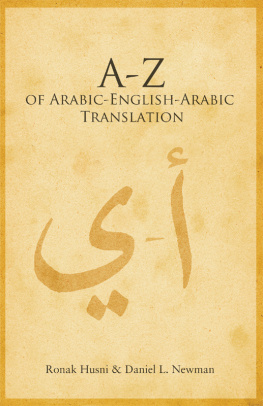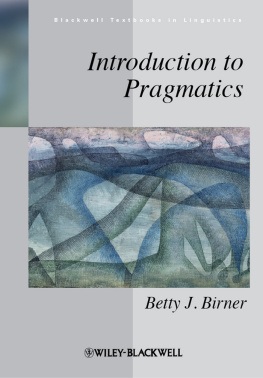Contents
Page List
CONTEMPORARY STUDIES
IN DESCRIPTIVE LINGUISTICS
Vol. 40
Edited by
PROFESSOR GRAEME DAVIS & KARL A. BERNHARDT
PETER LANG
Oxford Bern Berlin Bruxelles Frankfurt am Main New York Wien
Ali Almanna
SEMANTICS FOR
TRANSLATION STUDENTS
ARABICENGLISHARABIC
PETER LANG
Oxford Bern Berlin Bruxelles Frankfurt am Main New York Wien
Bibliographic information published by Die Deutsche Nationalbibliothek
Die Deutsche Nationalbibliothek lists this publication in the Deutsche Nationalbibliografie; detailed bibliographic data is available on the Internet athttp://dnb.d-nb.de.
A catalogue record for this book is available from the British Library.
Library of Congress Cataloging-in-Publication Data
Names: Almanna, Ali, author.
Title: Semantics for translation students : Arabic-English-Arabic / Ali Almanna.
Description: Oxford ; New York : Peter Lang, 2016. | Includes bibliographical references and index.
Identifiers: LCCN 2016014193 | ISBN 9781906165581 (alk. paper)
Subjects: LCSH: Arabic language--Translating into English. | Arabic language--Semantics. | Arabic language--Composition and exercises.
Classification: LCC PJ6403 .A36 2016 | DDC 428/.02927--dc23 LC record available at https://lccn.loc.gov/2016014193
ISSN 1660-9301
ISBN 978-1-906165-58-1 (print) ISBN 978-3-0353-0840-2 (ePDF)
ISBN 978-1-78707-122-3 (ePub) ISBN 978-1-78707-123-0 (mobi)
Peter Lang AG 2016
Published by Peter Lang Ltd, International Academic Publishers,
52 St Giles, Oxford, OX1 3LU, United Kingdom
Ali Almanna has asserted his right under the Copyright, Designs and Patents Act, 1988, to be identified as Author of this Work.
All rights reserved.
All parts of this publication are protected by copyright.
Any utilisation outside the strict limits of the copyright law, without the permission of the publisher, is forbidden and liable to prosecution.
This applies in particular to reproductions, translations, microfilming, and storage and processing in electronic retrieval systems.
This publication has been peer reviewed.
About the author(s)/editor(s)
ALI ALMANNA has a PhD in Translation Studies from the University of Durham and is Associate Professor of Linguistics and Translation at Sohar University, Sultanate of Oman. He is a specialist in translation theory, particularly the theoretical annotation of translation. His recent publications include The Routledge Course in Translation Annotation.
About the book
This book is an introduction to semantics for students and researchers who are new to the field, especially those interested in ArabicEnglish translation and ArabicEnglish contrastive studies. The book first presents key concepts in semantics, pragmatics, semiotics, syntax and morphology and gradually introduces readers to the central questions of semantics. These issues are then analysed and discussed in conjunction with the act of translating between Arabic and English. Seeking a balance between theoretical developments and empirical investigation, the book thus provides both a systematic overview of semantics and an application in the field of English and Arabic contrastive semantics, hence offering a resource for students and teachers of ArabicEnglish translation.
This is an extremely useful, well organised, clearly written, pedagogically oriented work aimed at students of Arabic/English translation. The chapters are coherently organised and cover a wide range of central topics in semantics. This book fills a real gap and will be of use to students of translation at undergraduate, masters and doctoral levels.
James Dickins,
University of Leeds, UK
Written in a highly pedagogical language and filled with useful examples and exercises, it aims to give future translators the unquestionably necessary training in the field of linguistics/semantics and its application to translation.
Juan Jos Martnez Sierra,
Universitat de Valncia, Spain
It is a useful book with clear definitions, lush examples and insightful summary questions. It will be most welcome for those willing to ground their intuitions on translation on more solid linguistic (and especially semantic) foundations.
Nicolas Froeliger,
Universit Paris Diderot (Paris 7), France
This eBook can be cited
This edition of the eBook can be cited. To enable this we have marked the start and end of a page. In cases where a word straddles a page break, the marker is placed inside the word at exactly the same position as in the physical book. This means that occasionally a word might be bifurcated by this marker.
| vii
This book provides an engaging and accessible introduction to semantics for students and researchers who are new to the field. It introduces the basics of semantics in a simple fashion. It adopts a step-by-step approach, starting with the basic concepts and gradually moving readers to the central questions in semantics to discuss them in a direct link with the actual act of translating. It strikes a balance between theoretical developments and empirical investigation. In addition to gaining a systemic overview of semantics, readers can learn how to argue for analysis, thus being able to annotate their own translation academically. Specialists in language-related fields, such as linguistics, semantics, pragmatics, semiotics, morphology, syntax, and translation will find this book an essential resource and reference.
Among the significant concepts introduced in this book are denotation, connotation, sense, reference, the open choice principle, the idiom principle, semantic roles, semantic relations, semantic field, componential analysis, meaning postulates, frames, scripts, paradigmatic axis, syntagmatic axis, speech acts, implicature, the cooperative principle, and semiotics.
This academic textbook is an accessible coursebook for students of Arabic-English translation, Arabic-English contrastive studies, and students of linguistics and semantics. The book is primarily designed for those whose mother tongue is either Arabic or English and who have some knowledge of both linguistics and semantics (at a basic level) and translation studies (at a basic level).
Although the topics and analyses used in this book are intrinsically of different levels of complexity (in particular the complexity levels are different within the analysis of examples in Chapters 411), the book is designed to be useful for true beginners, including those with very little background in linguistics in general and semantics in particular. The intended readership for this book is BA students of applied linguistics, semantics, Arabic-English contrastive studies, and Arabic-English translation studies. Further, MA and PhD students in translation, applied linguistics, and contrastive vii | viii studies may also benefit from this book. In addition, students with majors in subjects other than applied linguistics or English, such as translation, might be required to take a semantics course. The book features authentic materials taken from different text types, including literary texts, journalistic texts, religious texts, legal texts, and so on.
There are a number of books on the market that explain semantics, such as the following:
Carter, R. (1998). Vocabulary: Applied Linguistic Perspectives. London/New York: Routledge.
Cowie, A. P. (2009).

